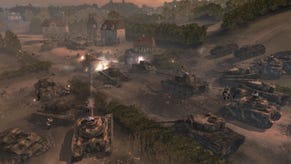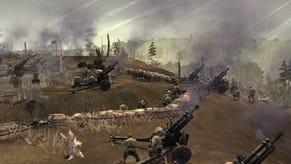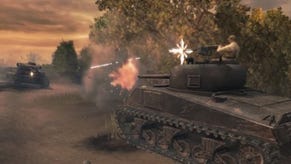Land Of The Free: Company Of Heroes Online
Land Of The Free is an ongoing series looking at free to play games. This week we dip into the ongoing Company of Heroes Online beta.
Coming back to Company of Heroes, after all this time, feels somewhat akin to returning to your parents house. It’s the same place, and you spent a lot of time here, but somehow, something is different. And that something is you.
Company of Heroes was brilliant. It reinvigorated the RTS, and ensnared new fans left right and centre. It created something that made sense, transcending beyond the cookie-cutter base building focused genre and providing us with an experience that was that much more believable and engaging. And then Men of War came along and ruined it all. Or at least, it did for me. Not being able to select single units and position them, not able to accurately attack certain parts of an enemy tank, not having the absolutely vital ability to shoot off my enemy’s hats, and then steal them for myself, is jarring. I’ve been spoiled.
And so I’m returning to the house that is Company of Heroes, and I’m a different man to the one that enjoyed these mechanics so thoroughly. But the house has had some renovation, and really, it’s this that might just lure me back in. You see, Company of Heroes isn’t an RTS any more. Not purely. Now it’s got some RPG running through it’s veins.

It works like this: you have to create a commander when you start the game. You select from Allies or Axis, and then from one of three different archetypes that fit neatly into the ‘Turtling, Blitzing and Othering’ play styles that permeate strategy games. Whatever you choose, everyone still plays with the same units, but each different class has a bunch of support abilities and unique units that augment what you do, and how you do it.
Playing the game gives you experience and supplies. The experience levels you up, and the supplies can be spent on upgrades and units. Leveling up gives you points to spend on your skills, which all boost and unlock abilities that you use during the game once you hit the required commander level. These range from artillery strikes to forced enemy retreats, and everything in between. The clever thing is, depending on which play style you picked, they are entirely different, each one serving to better aid the way you play. Pick offensive and you’re going to have abilities that boost your unit speed, or provide a rolling barrage to better attack. Defensive supplies the opposite, and the other has a range of psychological based abilities, like scaring the bejeesus out of your opponent’s troops.

Fie! I hear you cry, claiming that these are going to unbalance matches to a silly degree, allowing people who’ve played longer access to far more powerful abilities, able to crush you with a mere glance. I have a counter to that specific point, and it comes in the form of the commander points that served as your tech tree in the original game. Now these are purely passive, standing there to let you know what commander level you’ve reached in the game. Weaker abilities require a lower commander level, with the big guns only coming out when you’ve hit the higher eschelon of commanderdom. It’s a clever way of dealing with the issue, and you can only ever have so many abilities equipped, stopping you from spamming your enemy into submission with ever bigger explosions.
This thinking transfers through to the new upgrades and units, limiting how many you can have active at any one time, as well as cleverly hemming in the abuse of a particularly powerful unit. They’re called ‘Hero’ units, and tend to have passive bonuses like more health, faster movement or better guns, and they come with a set amount of charges. These can be replenished with the supplies you win from battles, meaning that you’re going to have an out-of-battle economy to manage.

Not only this, but you’re presented with an HQ, fully equipped with every building you can build in the game, and each one of these has a set number of slots. You might have three hero tanks you want to play with, but if your tank depot only has a single slot, you can only take one of them into battle with you. So you’re going to have to tweak your hand like a deck of cards, trying to figure out which set of units compliments one another best, rather than just sticking them in willy nilly.
The army upgrades, too, are constrained, with you having only six slots to pop them into. Things like armour upgrades for all tanks that shove metal skirts on their sides, or improved weapons for your infantry are huge boosts, but once you’ve got enough bonuses to fill up your slots, the only advantage higher level players are going to have over you is more options. Luckily, that initial hump is made much, much easier by a pretty extensive tutorial.

You might think that you’ve played Company of Heroes before and thus you’re above playing a tutorial, but Relic are one step ahead of you. In big text, the first time you start up the game, you’re informed that if you complete the tutorial missions you’ll get far, far more rewards and experience than if you just jumped straight into the multiplayer, and that temptation for loot and levels should be enough to tempt you into, at the very least, having a look at the tutorial missions.
They’re quick, and relatively interesting, placing you in scripted scenarios to inform you of how the game plays, and (most of the time) it lets you skip through the text, meaning that if you remember everything you can breeze through them. And once each tutorial mission is completed, you get a nice shiny new level, and most of the time at least one reward item. Not only that, but it spends far more time informing you about the additions to the game rather than the basics that you already know.
And if you’re still unclear on how to play, and you never played the original, there’s always the single player campaign. The original game, in its entirety, is there and available to play, for free. It almost sounds like madness, but I guess Relic and THQ figured that they’d managed to get all of the money they were going to get out of it with numerous Steam sales and retail boxes, and so they’re just giving it away. A touch altruistic, but there is a motive. Because, after all, they’re trying to make money with this, and they’re doing it in a pretty smart way. There’s a store, as there always is, and it contains things like increased experience rates along with pretty much every unit reward and upgrade you could dream of. The smart thing is, though, that they’ve all got supply costs too. Either you spend some money on Company of Heroes points, or you earn up enough supply points to buy what you want anyway. Obviously things are skewed towards the paying customer, but it’s important not to drive a great big divider between those who pay and those who don’t. It’s a lesson that’s taken a while to sink in, but free to play games seem to be understanding it.
And so Company of Heroes Online is the same old Company of Heroes, except it really isn’t. It’s reiterated, augmented and improved upon to make sure that you’re going to want to stick around and earn some rewards and experience. The lessons learned from Dawn of War 2 are shining through, and Relic know that if you provide people with an incentive for repeat play outside of the actual game experience itself, people are that much more likely to come back again, and again, and again.







